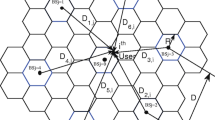Abstract
The aim of this paper is to evaluate experimentallythe performance of different space diversity schemesat the base station end in a semi-urban microcellularenvironment. The receiving antennas were separated inhorizontal, vertical or compound direction in order toprovide decorrelated signals. The superior receivedsignal was chosen based on the selection combiningcriterion. A measurement campaign was conducted atboth appropriate frequency bands (900 MHz and 1800 MHz) for mobiletelecommunications. Measurements wereperformed along the route containing bothline-of-sight (LOS) and non-line-of-sight (NLOS)paths. The measured data was analyzed and signalcross-correlations, signal mean levels of individualreceiving branches and diversity gains of differentreceiving antenna separations (horizontal, verticaland compound) were evaluated. According to themeasurements, low signal cross-correlations andreasonable diversity gain at the base station end canbe achieved even with ≤4λ separation ofthe receiving antennas in any direction at both 900 MHz and 1800 MHz frequencybands. The obtained resultsalso showed that horizontal, vertical and compoundspace diversity gains are almost the same. Hence,spatially small and variable antenna configurationsfor space diversity reception can be applied at thewall installations in a microcellular environment.
Similar content being viewed by others
References
W.C. Lee, Mobile Communications Engineering, McGraw-Hill, 1982.
D. Parsons, The Mobile Radio Propagation Channel, Pentech Press, 1992.
O. Norklit, C.F Eggers and J.B Andersen, “Jitter Diversity in Multipath Environments”, in Proc. 45th IEEE Veh. Tech. Conf., Chigago, 1995, Vol. 2, pp. 853–857.
T. Aubrey and P. White, “A Comparison of Switched Pattern Diversity Antennas”, in Proc. 43rd IEEE Veh. Tech. Conf., Secausus, 1993, pp. 89–92.
A.M.D Turkmani, A.A Arowojolu, P.A Jefford and C.J Kellett, “An Experimental Evaluation of the Performance of Two-Branch Space and Polarization Diversity Schemes at 1800 MHz”, IEEE Transactions on Vehicular Technology, Vol. 44, no.2, pp. 318–326, 1995.
W.C. Jakes, Jr. (ed.), Microwave Mobile Communications, Wiley-Interscience, 1974.
D. Kitchener, J.E.J. Dalley and M.S. Smith, “Antenna Diversity in Outdoor Microcells”, in Proc. Ninth International Conference on Antennas and Propagation, Eindhoven, 1995, Vol. 2, pp. 1–4.
J.S. Milton and Jesse C. Arnold, Introduction to Probability and Statistics, McGraw-Hill International Editions, 1990.
Author information
Authors and Affiliations
Rights and permissions
About this article
Cite this article
Lempiäinen, J.J. Experimental Evaluation of Space Diversity Schemes at a Base Station in a Microcellular Environment at 900 MHz and 1800 MHz. Wireless Personal Communications 14, 1–11 (2000). https://doi.org/10.1023/A:1008995021882
Issue Date:
DOI: https://doi.org/10.1023/A:1008995021882




